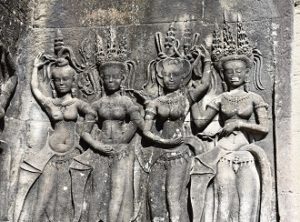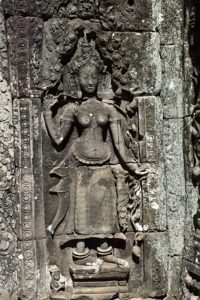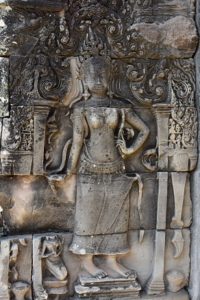Apsaras form a significant part of the mythology of Churning of the Ocean. Tanny, my guide told me there were nearly 1800 figures of Apsaras alone within the Wat, all with distinctively different delicate facial features , different finery & attires, hairdo and distinctively different jewelry and facial expressions – both facial expression as also bodily expressions. Another feature one noticed that there must be a hierarchy even amongst these. Someone must be senior to the others as we have in different organisations today. There is one whose dress is much superior to the others. And then there is one who has another Apsaras clearly subordinating to her.
, different finery & attires, hairdo and distinctively different jewelry and facial expressions – both facial expression as also bodily expressions. Another feature one noticed that there must be a hierarchy even amongst these. Someone must be senior to the others as we have in different organisations today. There is one whose dress is much superior to the others. And then there is one who has another Apsaras clearly subordinating to her.
Legend has it that Churning of the Holy Ocean was arranged by Lord Vishnu after the Gods had lost all their powers through a curse at the hands of the Sage Durvasa. And as a result, the demons wrested control of all the universe and the Gods became irrelevant. Repression of King Bali of the Demons was untold and the Gods went to Lord V ishnu for help. Whilst showing his inability to turn the curse back, He told them for a way out; it being to have a truce with the demons. And make them ready for churning of the Holy Ksheer Sagar so that the Holy Nectar ‘The Amrit’ shall come out which the demons can drink and become immortal. They all arranged for this mammoth task. The entire process is being dealt with separately in my work. Here it is only relating to the advent of the Apsaras, the Godly Angels, the fairies or the danseuses.
ishnu for help. Whilst showing his inability to turn the curse back, He told them for a way out; it being to have a truce with the demons. And make them ready for churning of the Holy Ksheer Sagar so that the Holy Nectar ‘The Amrit’ shall come out which the demons can drink and become immortal. They all arranged for this mammoth task. The entire process is being dealt with separately in my work. Here it is only relating to the advent of the Apsaras, the Godly Angels, the fairies or the danseuses.
As the process of churning began, many jewels came out including The Amrit. During the process, lots of droplets of the Holy Ocean also got spread around. These droplets became ‘the Apsaras’.
It is one of the tenets in temple building as per various Shastras, that the temple walls must be adorned with the legends connecting with the particular Holy Deity. At Angkor, since the Chief Deity has remained Lord Vishnu Himself, all the walls have been sculpted with art & architecture that pleases Him; ultimately it is His playground, this Temple Complex.
The entire beauty has been detailed in Bas-Relief by master sculptors. It is my serious belief, though unsubstantiated th rough any records, which in any case aren’t available, that those artists, artisans and those Acharyas (Priest-Architects) must have been shipped from India for such deep knowledge was only available then, which fact is born by work at the Temples at Madurai, Kanchi, Rameswaram and at such other places. These are as lively today as these must have been then, nearly a thousand years ago.
rough any records, which in any case aren’t available, that those artists, artisans and those Acharyas (Priest-Architects) must have been shipped from India for such deep knowledge was only available then, which fact is born by work at the Temples at Madurai, Kanchi, Rameswaram and at such other places. These are as lively today as these must have been then, nearly a thousand years ago.
Coming back to the Apsaras. Such Apsaras as Rambha, Menaka, Urvashi, Ghritachi and Tilottama have been mentioned in the Holy Scriptu res, they are the flying Angels who are considered as the spouses of the Gandharvas who would compose music in the courts of the Gods and these Apsaras shall dance. They change their appearance at will and are expert dancers.
res, they are the flying Angels who are considered as the spouses of the Gandharvas who would compose music in the courts of the Gods and these Apsaras shall dance. They change their appearance at will and are expert dancers.
The legend of the Apsaras is not restricted to India alone. Indonesia, Bali, Cambodia and even Philippines and China, all have some forms of these Apsaras in their culture. Incidentally, the Hotel where I have stayed has very fine sculptures of these Apsaras adorning the Hotel walls.
It is congruent to mention that in the Temple art & architecture, there are strict norms for creating such sculptures. their shapes, sizes, their height & width of each bodily part is defined lest it goes awry and ratio proportion of such creations appear distrac ting. This form of the art & craft is learnt by dedicated apprentices from masters at a really very slow pace lest some very significant steps in the entire process of learning are left out. It is easily fathomable from the quality of artwork at Angkor, that the sculptors must have been truly masters of their art. But, then there must also have been a constant replenishment of such great artists from sources where they must be continuously learning the paces from their master seniors.
ting. This form of the art & craft is learnt by dedicated apprentices from masters at a really very slow pace lest some very significant steps in the entire process of learning are left out. It is easily fathomable from the quality of artwork at Angkor, that the sculptors must have been truly masters of their art. But, then there must also have been a constant replenishment of such great artists from sources where they must be continuously learning the paces from their master seniors.
Only the very best must have been accepted for the work at Angkor. no wonder than that each of the celestial maidens at Angkor bear distinct expression and no two are similar even in their facial construction. I, with closed eyes try imagine that I am standing beside them and observe their dedication, styles, movement of their hands, the tools they are using and watch their supervisors who would audit every moment’s work with the precision of a hawk. Creating these lovely looking yet intricately delicate Apsaras wasn’t easy ride. One mistake and all hell let loose. Amazing, isn’t it?
Yet another interesting feature must have been related to the logistic s of this creativity in terms of resourcing tools for thousands of these craftsmen. where would they be sourcing the metals, materials, the blacksmiths and the like from. The more one thinks, more intricate it appears because one has experienced these difficulties whilst leading projects in this most modern of eras. What must have been the situation a thousand years ago?
s of this creativity in terms of resourcing tools for thousands of these craftsmen. where would they be sourcing the metals, materials, the blacksmiths and the like from. The more one thinks, more intricate it appears because one has experienced these difficulties whilst leading projects in this most modern of eras. What must have been the situation a thousand years ago?
How easy or how much difficult must have been the creation of these Apsaras, He only knows best?